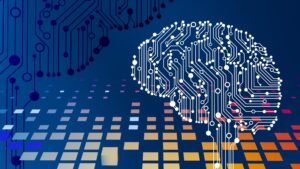7 AI Trends Sweeping Cybersecurity

As cyber threats evolve in complexity, AI has emerged as a formidable ally. It empowers organizations with advanced tools and techniques, helping them to stay one step ahead of malicious actors.
In this exploration, we delve into cutting-edge AI trends that are reshaping the cybersecurity realm as well as fortifying defenses against an ever-expanding array of cyber threats. Ironically, some of those new cyber threats come from AI.
The Rise of AI in Cybersecurity
As cyber threats grow in sophistication, traditional measures face challenges in keeping pace. This is where AI steps in to offer a dynamic and adaptive approach to cybersecurity.
Machine learning algorithms, neural networks, and other AI technologies analyze vast datasets at unprecedented speeds. They identify patterns and anomalies that might elude human detection.
58% of security professionals expect a completely new set of cyber risks in the coming years.
The integration of AI in cybersecurity doesn’t replace human expertise. AI doesn’t have judgment. Instead, it enhances it to allows security professionals to focus on strategic decision-making. AI handles the heavy lifting of data analysis and threat detection but humans still have to make decisions.
AI Trends Sweeping the Cybersecurity Realm
1. Predictive Threat Intelligence
AI is revolutionizing threat intelligence by enabling predictive capabilities. Machine learning algorithms analyze historical data, current threats, and emerging patterns to predict potential future cyber threats. This proactive approach allows organizations to put in place preemptive measures as well as close vulnerabilities before hackers exploit them.
2. Behavioral Analytics
Traditional signature-based approaches struggle to keep up with zero-day attacks as well as advanced “smart phishing.” But AI-driven behavioral analytics take a different approach, focusing instead on understanding the normal behavior of systems and users. Deviations from these patterns trigger alerts to help identify potential threats. Identification is based on anomalous activities rather than known signatures.
3. Autonomous Security Systems
The concept of autonomous security systems, empowered by AI, is gaining prominence. These systems can automatically detect, analyze, and respond to cyber threats in real-time. This minimizes response times and reduces the impact of security incidents. The ability to automate routine security tasks enhances efficiency. It also allows human experts to focus on strategic aspects of cybersecurity. Of course, it carries its own risks, and it will be a while before a functional autonomous security system is viable.
4. Explainable AI (XAI)
AI plays an increasingly critical role in cybersecurity decision-making. This involvement makes the need for transparency paramount. Explainable AI (XAI) addresses this concern by providing insights into how AI algorithms reach specific conclusions. This enhances trust in AI-driven cybersecurity and helps security professionals understand the decisions made by AI systems.
5. Cloud Security Augmentation
With the proliferation of cloud services, securing cloud environments has become a priority. AI is being leveraged to enhance cloud security. A few ways that it does this is by:
- Monitoring activities
- Detecting anomalies
- Responding to threats in cloud-based infrastructures
The dynamic nature of cloud environments requires adaptive security measures, making AI a natural fit for bolstering cloud security.
6. Deception Technology
Deception technology involves creating decoy assets within an organization’s network to mislead attackers. Companies are now integrating AI into deception technology to make decoys more convincing as well as more responsive to attackers’ behavior. These decoys help in early threat detection while providing valuable insights into attacker tactics and techniques.
7. Zero Trust Architecture
Zero Trust Architecture, supported by AI, challenges the traditional security model. Where systems trust entities inside and distrust entities outside the network. AI-driven continuous authentication and monitoring ensure that trust is never assumed. It dynamically adapts access privileges based on real-time assessments of user behavior and risk factors.
Embracing the Future of Cybersecurity with AI
As the threat landscape evolves, the incorporation of AI in cybersecurity is important. It’s not just a strategic choice, it’s a necessity. These AI trends mark a paradigm shift, enabling organizations to build more resilient and adaptive cybersecurity frameworks.
It’s important to stay informed and embrace the transformative power of AI to help businesses navigate the complexities of the digital landscape with confidence, fortifying defenses against emerging threats.
AI stands as a beacon of innovation. It continually pushes the boundaries of what’s possible in the realm of cybersecurity. The symbiotic relationship between human expertise and AI-driven capabilities is vital, shaping the future of data security. Using AI well ensures a safer digital landscape for businesses and individuals alike.
Why Is This Published By A Business Phone Company?
Here at NoContractVoIP, we believe that your success creates our success. And, since we specialize in business communication, we work to help you communicate better while staying safe. We create the cutting edge communication systems that modern companies need. And we geek out on tech stuff, so we study it for you.
To talk to a business phone system specialist and never worry about any of this again, call 866-550-0005 or contact us today.
To get the latest helpful content delivered to your inbox every month, subscribe to our newsletter here.
